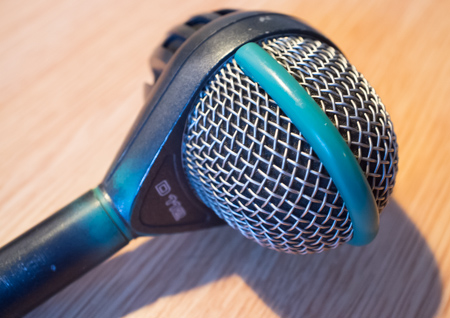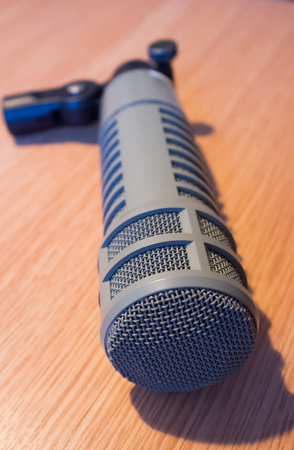IoSR Blog : 3 December 2013
Microphone of the month - November
It's microphone of the month time again (the microphone that has been booked the most in the month of November - see here for more). Well actually, the winner for November was the same as last month (we have over 100 microphones and our students are still using the same one most?). So to save it getting boring so soon, we've awarded microphone of the month to the runner up instead.
Microphone runner-up of the month

The microphone of the month for November is the AKG D112. This is a popular mic that has been in production for over 30 years, and is commonly used a kick-drum microphone for live and studio use. AKG claim that:
"Heavy-footed drummers are thrilled with the D112´s ability to handle up to 160dB SPL without any distortion. The diaphragm has a very low resonance frequency to maintain a solid and powerful response below 100Hz. A narrow band presence boost at 4kHz punches through dense mixes with forceful impact - no additional EQ needed!"
There's certainly no argument that it's not a particularly neutral microphone. The combination of low resonant frequency and boosted HF give it a response that looks more Pennines than Norfolk, as can be seen in the figure below.

Whether it's a good or bad thing that the microphone has such pronounced colouration rather than leaving it to the skill of the engineer and their chosen EQ is a matter of debate. What's for sure is that this is a very popular microphone, both with our students, and with engineers more widely.
Dusty wallflower of the month
When we announced the microphone of the month last time, associate lecturer Rupert Flindt suggested that we should also have "dusty wallflower of the month", to highlight under-used and under-appreciated microphones in the department. So, for this month, I'm using this as an opportunity to look at an alternative to the D112 - the Electrovoice RE-20.

Electrovoice call this a "broadcast announcer microphone", and for this they have included a variable high-pass filter that can be used to offset boominess for close sources caused by the proximity effect. So why has it found common use as a kick-drum mic? A number of factors probably, including a wide frequency range, ability to cope with high sound pressure levels, and a significant wind filter. Plus, the housing is steel and will probably dent the floor rather than being dented itself if you drop it.
Compared to the D112, the frequency response is much more even, though probably not what you would call ruler flat. This means that the sound isn't as hyped to begin with, but this might allow easier tailoring to the sound you want.

If you want to compare the D112 and RE-20 for kick-drum recording, there's a useful video below. But why not experiment with a few mics, and see what works best for each situation? You never know what you might find ...
And as a footnote, have a look at www.microphone-data.com, which includes specifications of wide range of microphones, and allows searching based on almost any parameter. It also includes a library of useful articles. You'll need to register for an account, but it's probably worth it.
by Russell Mason
